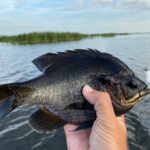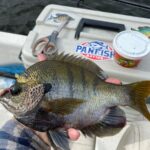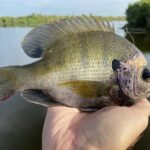Carp are one of the most common fish species in the world and are found throughout Asia, Europe, and the United States.
While considered a delicacy in much of the world, carp have a terrible reputation in the United States, mostly among people who have never tried eating carp.
So, are carp really good to eat? If so, why the stigma? Let’s dive in!
This page contains affiliate links. As an Amazon Associate, I earn from qualifying purchases.
Table of Contents
Is Carp Good To Eat?
If properly prepared, carp are good to eat. The meat is pink and mild-flavored similar to Tilapia. As with all fish, where it is caught, and how it is handled and prepared is a big factor in taste and flavor.

Carp are considered a rough fish, which means they have thick scales and skin, and a lot of bones. This makes them somewhat challenging to clean and fillet.
However, when Carp are prepared and cleaned properly, the meat itself is quite good! Many anglers in the United States do not take the time to clean around all the bones or cook this large freshwater fish properly.
Is The Meat Clean and is it Fresh Carp?
Like most fish, the meat is as clean as the environment the fish lives in. If you catch a carp in muddy, disturbed, or polluted water, this is going to affect the smell, taste, and quality of the meat.
You want the carp you catch for your table to be coming from the cleanest water possible, where they have been eating a healthy and diverse diet of plants, mollusks, and insects.
If you are taking carp from clean water, you don’t need to worry about a muddy flavor. A carp from a muddy, polluted river will smell and taste bad; but so will a bass or any other fish from that waterway!
You often hear the term “bottom feeder” used to apply to carp, with the connotation being that they are unclean animals picking unclean things out of the bottom mud.
This is not the case. Carp actually tend to have lower concentrations of pollution than many game fish due to their omnivorous diet. They are not bottom feeders.
Their reputation as pollution and disease-ridden “river pigs” is totally unjustified. A carp from a clean, pollution-free river will give clean, pollution-free meat.
As with any other fish, you don’t want to eat the really big ones, as larger, older fish tend to have more of a buildup of environmental contaminants.
See Also: What Do Carp Eat? 5 Of The Best Baits To Catch Carp
What Does Carp Taste Like?
Carp meat is moist, flaky meat with a high percentage of healthy fish oils. It’s firm meat, often ‘chunked’ or filleted whole.
The flavor is unique and quite mild. As it has a high content of oil, it’s been compared favorably to salmon or Tilapia.
If it’s prepared and handled properly, there’s no fishy or muddy taste whatsoever.
Why Do People Think Eating Carp Is Bad?
This is a fascinating question. Carp are viewed as one of the best fish species to eat in almost every other part of the world. For most of the 19th century, they were viewed as a delicacy in North America as well. Yet, now their reputation in North America is terrible.
Carp are called “junk fish” or “trash fish“. Many anglers view hooking a carp as a disappointment, not a success.
But that’s just wrong!
So what happened to change the carp’s reputation?
Not Considered A ‘SportFish’
In the United States, Carp fishing is not nearly as popular as it is in other parts of the world like Europe, South Africa and Asia.
In fact, the carp is the most popular freshwater gamefish in the entire world!
(If you’re in the market for a carp and catfish rod, check out the Shakespeare Ugly Stik Spinning Combo…its affordable, durable and ugly- just like big carp, ha!)
But, In the united states, they have a poor reputation. Many anglers prefer gamefish like largemouth bass, walleye, and musky.
It’s no different than some anglers thinking catfish are trash fish too!
The truth is, carp are a fascinating fish and challenging in their own right. If you devote some time to study these fish, and the methods used to catch them you will see why they are popular in other parts of the world.
Abundance
Throughout the 18th Century, carp would sell for very high prices in fancy restaurants. Then, as more and more people, and the United States government, continued to import, spread, and farm carp, the market was flooded with massive amounts of carp meat and the prices crashed.
Carp was soon cheaply available to everyone and went from being an exclusive treat to a cheap food of the masses. Carp became viewed as food for poor people. Essentially, carp lost popularity in large part due to oversupply.

Ecological Damage
The ecological damage carp do is overstated, but it is still real.
Carp are currently listed as one of the 100 most invasive species on the planet.
They can change the characteristics of the environment to the detriment of native species, reproduce quickly, and out-compete and may even replace game species in some places. Because of this, they began to be viewed with disdain.
Carp are hardy and can survive in harsh conditions. They soon became identified in people’s minds with dirty, polluted water.
Many local governments and water management agencies introduced carp into canals, ditches, and retention ponds to control aquatic vegetation.
Carp have even been blamed for harming bass populations, as many anglers suspect they eat the eggs.
What is the Best Carp Species Is Best To Eat?
All species of carp are good to eat, but some are preferred among others. All species of Carp contain high amounts of healthy fish oils, vitamins, minerals, and high-quality proteins.
While there’s some variability among species, preparation is more important than species as far as flavor is concerned.
Crucian carp, a European species that is relatively rare in North America, is said by some to be the best to try for people new to eating carp.
For US Anglers, Bighead Carp and Silver Carp are among the tastiest. Common Carp are edible, but they have much darker meat and a bit stronger flavor.
I personally think Silver Carp are the most flavorful, and they are abundant (and fun to catch!) in the Mississippi and Missouri river watersheds.
Here are a few other popular types of Carp:
- Pickle Carp
- Grass Carp
- Bighead Carp
How Do You Prepare Carp and Cook Carp?
People often talk about the supposed muddy flavor of carp meat.
The way to avoid this is to prepare carp the right way and handle of the fish correctly!
There are two distinct phases to the preparation of carp. One takes place when you are out fishing and the other takes place when you get home.
First, pick your body of water carefully. Clean, unpolluted water will give you the best, mildest tasting fresh carp. Avoid stagnant ponds.
Instead, seek out rivers and watersheds with good drainage and bio-diversity.
Once you’ve caught a carp that’s the size that you want to eat, you need to bleed the meat.
You should kill the fish immediately with a blow to the head, followed by cutting the gills to bleed it out. A good trick is to put the carp head down in a bucket of ice water to speed the bleeding process.
Once the bleeding is done, get the carp on ice as soon as possible. This acts to retard the movement of any remaining blood into the meat and keep it fresh and give you the best carp taste possible.
Killing the fish quickly also minimizes the production of stress chemicals that make the meat taste bad.
The second phase of preparation is when you get home. First, you clean the slime off the fish. Most people will want to skin the carp as the scales and skin are very thick and tough.
Use a quality fillet knife, because carp have incredibly tough skin and scales so a sharp knife is critical. If you want to prepare carp with the skin on you will need to scale the fish, which is not easy to do with a carp.
With the skin off or the fish scaled, you can cut the carp fillet off just like you would with any other fish. Filleting carp takes a little practice but you will soon get the hang of it. Get as much back meat into your filet as possible; this is the best part of the carp.
Once you have removed the filets, locate and remove the bloodline before cooking. The bloodline contains most of the blood and oil in the filet.
Below the bloodline, you will see small bones called Y-bones.
You can manually dig out all the Y-bones but this will cost you quite a bit of meat. Many people just cook the filet as is and pick the bones out as they’re eating the fish.
After the filet is out, some soak it in brine or vinegar, but this shouldn’t be necessary. Just get it back on ice and cook it as soon as possible.
Pickling the filets can result in some of the Y-bone’s dissolvings. There is also a method of scoring and deep frying the filet that actually cooks the Y-bones out of it.
Fried carp, baking, and braizing are the best ways to cook carp. Curry dishes are very popular, as well as fish balls, soups, and baked ‘carp steaks’.
I prefer to lightly pan fry the carp I eat to where it has a slight golden brown exterior and top it off with lemon butter.
If you really want to take your carp (or any fish) cooking to the next level, I highly recommend Hook, Line and Supper by Hank Shaw.

It’s one of the most complete and detailed fish recipe books for cooking every type of fish, in every way imaginable. If you like to eat fish- this is the book for you!
History Of Carp As Food
One of the main reasons common carp are so widespread is because they have such a high reputation as a delicacy in most places.
They are native to Asia and parts of Europe. Due to their popularity as food, Asian carp have also been introduced around the world and are thriving and numerous species in North America.
As carp were so popular where they were native in Europe, they were soon introduced to fresh water in the rest of Europe and were a prized source of food.
At one time, carp were considered fit for the tables of kings and emperors and graced the feasts of the rich and mighty. Henry VIII of England had his own carp pond, whose sole purpose was to provide carp for his table.
Carp were brought to the United States in the mid-19th century by European immigrants who were homesick for the flavor of their favorite fish.
Carp has since become a popular traditional Christmas Eve Dinner option throughout Central and Eastern Europe.
In the 1870s carp were imported into the United States, primarily for use as food, and stocked massive amounts of various types of carp in reservoirs, ponds, lakes, and major rivers for aquatic weed control.
Carp were considered a delicacy in the United States in the late 19th century. Carp was on the menu at the most expensive restaurants and the hotels frequented by the rich and famous.
During this period, there were large-scale carp fishing and farming operations feeding the demand for carp throughout the United States.
So, yes, carp are good to eat. They are and have been prized throughout the world for their flavor, despite how they are viewed in the United States as a muddy river fish right now.
Final Thoughts
If someone says to me that “Carp taste like mud, and they are a trash fish and it’s not good to eat carp“, I say “Well, have you eaten it before?” and the answer is always the same…
“ugh…no..but I have heard they are a junk fish”
The truth is, the Carp species is simply not appreciated in the United States from a gamefish standpoint or as a food fish.
But there is good news. Trends are changing. Carp fishing is growing in popularity, and many people are open to trying carp for their next meal as the stigma around eating carp is slowly going away.
Follow the tips in this article, have some fun, and try carp fishing. Bring one home for dinner and you may be pleasantly surprised!
Thank you for reading.
You May Also Like: Are Freshwater Drum Good To Eat? You May Be Surprised!
If you haven’t guessed yet, I love fishing and everything about it!
To learn more about why I started Panfish Nation, visit the About page and follow along on Social Media:


Download a copy of my FREE Lure Color Selection Chart & Knot Guide!
Stay up to date with fishing reports, tackle reviews, industry news, and much more! We respect your privacy, unsubscribe at any time.
Related Posts
- Crazy Facts About the World Record Crappie
- What Size Hooks for Smallmouth Bass? Quick Guide
- Large and in Charge-Mouth: 10 of the Best Bass Lures of All Time (And Where to Buy Them)
- Emperor of the Sun(fish): What You Need to Know About the World Record Bluegill
- Coppernose Bluegills: How They’re Different from Common Bluegill
- Bluegill vs Brim: Differences & Terminology, Explained!






